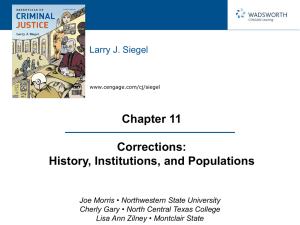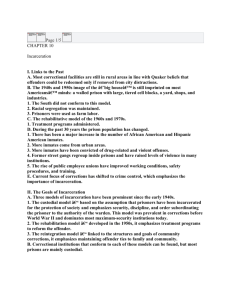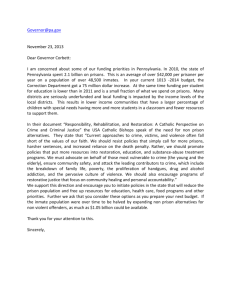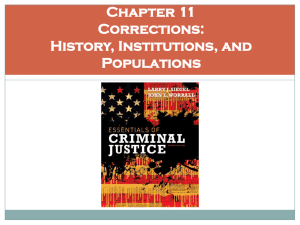History, Institutions, and Populations
advertisement
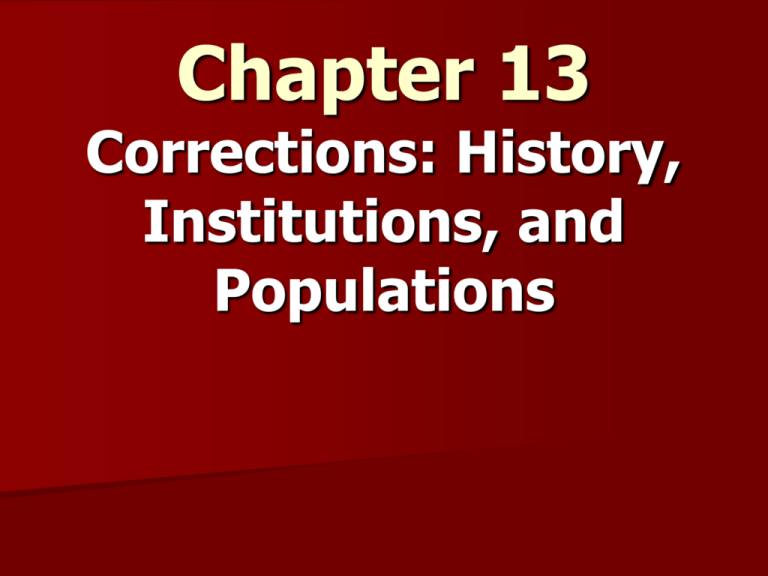
Chapter 13 Corrections: History, Institutions, and Populations The History of Correctional Institutions Prisons: state or federal correctional institution for incarceration of felony offenders for terms of one year or more Jails: place to confine convicted misdemeanants serving less than one year or to hold people awaiting trial The History of Correctional Institutions (cont.) Incarceration did not become the norm until 19th century Institutions constructed in England during the 10th century were used to detain debtors, unemployed, or those awaiting trial and punishment First penal institutions were foul places devoid of proper care, food, or medical treatment; many were run as private prisons In the 18th century hulks (mothballed, de-masted ships) were used to house prisoners in England, while awaiting transportation to colonies or execution Hulks had high death rates from disease and malnutrition Conditions in hulks lead to the creation of reform organizations in England (e.g., John Howard League) The History of Correctional Institutions (cont.) American developments – First American jail built in James City, VA – Confinement of liberty were often public (stocks, whipping posts) – Modern American correctional system had its origin in Pennsylvania under leadership of William Penn (who was a Quaker) The History of Correctional Institutions (cont.) Quaker influence – Philadelphia Society for Alleviating the Miseries of Public Prisons began focus on humane and orderly treatment – Influence on legislature resulted in limiting the use of the death penalty – Walnut Street Jail – Penitentiary house Basic policy: do penance, realize that you have sinned The History of Correctional Institutions (cont.) Auburn system – In 1816 New York built a new prison in Auburn hoping to alleviate overcrowding at other holding facilities – Tier system, because cells were built vertically on five floors – Also known as the congregate system – Three classes of prisoners were created: Those in solitary Those allowed labor as a form of recreation Those who worked and ate together during the day and separated at night (largest class) The History of Correctional Institutions (cont.) Pennsylvania system – Placed each inmate in a single cell – Classifications were abolished because isolation would prevent inmates from contaminating each other – Built in a circle with cells placed along its circumference The panopticon, Jeremy Bentham – Designed as a place for prisoners to do penance The History of Correctional Institutions (cont.) Prisons at the turn of the century – Prisons of the late 19th century were remarkably similar to those of today. – Development of prison industry Contract system Convict-lease system Prisons farms The History of Correctional Institutions (cont.) Reform movements – 1870 National Congress of Penitentiary and Reformatory Discipline began new era of prison reform – Zebulon Brockway, Elmira Reformatory, advocated individualized treatment, indeterminate sentences, and parole – Brockway’s achievements were limited although he did introduce a degree of humanitarianism into prisons – Regimes and treatment options were based on stereotypes of criminals (e.g., Italians were natural criminals; eugenics; social hygiene) – Elmira became a model for other states The History of Correctional Institutions (cont.) Creation of parole – 1850’s Walter Crofton created forerunner of parole in Ireland Inmates spent last portion of their sentences living in intermediate institution and working in outside community – Crofton’s success led to creation of similar programs in United States Focused on transition back into society The History of Correctional Institutions (cont.) Prisons at the turn of the twentieth century – Time of contrast in the U.S. prison system – Advocation of reform, rehabilitation, education, religion – Conservatives opposed to reform believed in stern disciplinary measures – Ultimately many reforms would be implemented The History of Correctional Institutions (cont.) Development of specialized prisons – Industrial prisons for hard-core inmates – Agricultural prisons for nondangerous offenders – Institutions for criminally insane Opposition by organized labor restricts the use of prison labor and sale of prison made goods The History of Correctional Institutions (cont.) Numbers: – About 1.3 million in prison, about 670,00 in jail (2005) – Costs: about 28,00 year for young adults rising to about 70,00 for older prisoners (health care, etc) and juveniles – About 720,000 employees in the prison/jail system The History of Correctional Institutions (cont.) Contemporary correctional trends – Prisoners’ rights movement – Violence within the corrections system became a national concern – View that traditional correctional rehabilitation efforts have failed prompted reconsideration of incapacitating criminals – From rehabilitation to punishment and incapacitation Jails Five purposes – Detain accused offenders who cannot make bail – Hold convicted offenders awaiting sentence – Principal institution of confinement for those convicted of misdemeanors – Hold probationers and parolees arrested for violations and waiting for a hearing – House felons when state prisons are overcrowded Jails (cont.) About 600,000 offenders are being held in jails today Number has risen significantly since 1990 even though crime rate has trended downward Almost 90 percent are males Poor, racial, and ethnic minorities are overrepresented Who Is in Jail, by Race and Ethnicity? Jails (cont.) Jail conditions – Usually low priority item in the criminal justice system run by county officials – No unified national policy on what constitutes adequate conditions – Among the most dilapidated and under funded confinement facilities in the USA – Administered by local police, sheriffs Current movement to remove people from jails through bail reform and pretrial diversion Jails (cont.) Jail overcrowding – Prison overcrowding forces officials to use local jails to house inmates – Mandatory jail sentences for drunk driving – Crackdown on substance abuse – Mandatory arrest policies for domestic violence Jails (cont.) New generation jails – Modern design to improve effectiveness – Use of pods or living areas rather than linear/intermittent surveillance model of traditional jails – Allow for continuous observation of residents – Believed to result in safer environment for staff and inmates – Seeks to involve inmates in controlling each other Prisons Types of prisons – Maximum-Security: houses dangerous felons, strict security, high walls, limited contact with outside world – Super-Maximum Security: used to incapacitate most dangerous felons with 23 hour day lockdown – Medium-Security: less secure institution to house nonviolent offenders and provides more contact with outside world – Minimum-Security: houses white collar and nonviolent offenders, few security measures, liberal furlough and visitation policy Alternative Correctional Institutions Prison farms and camps – Found primarily in the South and the West – Prisoners on farms produce dairy products, grain, and crops – Forestry Camp inmates maintain state parks, fight forest fires, and do reforestation work – Some famous for abuses and mistreatment of prisoners (Angola, Tucker Farm) Alternative Correctional Institutions (cont.) Shock incarceration in boot camps – Typically for youthful, first-time offenders – Military discipline and physical training – Short periods of high intensity exercise will shock the inmate into going straight; “scared straight” – Some have educational and training elements Alternative Correctional Institutions (cont.) Evaluating shock incarceration – Cost is no lower than traditional incarceration – High failure rates – Doris Layton Mackenzie – Reduce prison overcrowding Alternative Correctional Institutions (cont.) Community correctional facilities – Bridge the gap between institutional living and the community – Offer specialized treatment – Used as intermediate sanction – Halfway houses Alternative Correctional Institutions (cont.) Private prison enterprise – Percy Amendment (1979) – State-use model – Free-enterprise model – Generally limited to few experimental programs Alternative Correctional Institutions (cont.) Private prisons – Prisons operated by private firms as business enterprises; run for profit – Expectations specified in contract with government – In some instances private company builds the prison and leases it back to the government allowing state to avoid the difficulty of getting voters to approve bond issues. – Some companies contract to provide specific services in an institution such as medical or food services – (2006) 264 prisons, hold about 95,000 prisoners Alternative Correctional Institutions (cont.) Evaluating private prisons – Some research shows recidivism rates lower for private than state-operated prisons But “Creaming” – tend to take the best prisoners – Private and public prisons cost about the same to operate, but privates are cheaper to build Alternative Correctional Institutions (cont.) – Concerns over profit-driven decisions by private prisons Quality and training of personnel; provision of services (food, medical, treatment) as cheaply as legally allowed – Unresolved legal issues: mistreatment of prisoners, use of deadly force and immunity from lawsuits – Effects on inmates: Often sent far away from home, families cannot visit, isolation and difficulty of reintegration Correctional Populations Reflects common traits of arrestees held in local jails: young, single, poorly educated, male, and minority group members. Number of women incarcerated is increasing at a faster rate than males Many inmates suffer from multiple social, psychological, emotional, and health problems Prison populations continue to increase despite a decade long drop in the crime rate Prison and Jail Population Trends Correctional Populations Some numbers for prisons: – About 640/100,000 (2005) – highest ratio in the world Female rate: 60/100,000; Male rate: 906/100,000 Race/ethnicity rates: – White: 450/100,000; – Black: 3,437/100,000 – Hispanic: 1,176/100,000 – Offenses committed: about 45 percent violent; about 15 percent property; about 15 percent drugs; about 9 percent public order offenses Correctional Populations – Corrections and race, ethnicity, and gender Prison experience (2001): – 5.6 million adults have been in prison – Blacks: 17% of adults; Hispanics 7.7%; Whites: 2.6% – Men: 11.3%; women: 1.8% Life rates: chances of being in prison during life for adults – These are projected numbers from current practices Blacks: 1 in 3 will experience prison Hispanics: 1 in 6; Whites: 1 in 17 Correctional Populations (cont.) Explaining population trends – Legislation fueled by public concern about drugs and violent crime – A large proportion of new admissions are for drug offenses – Use of mandatory sentences – Truth in sentencing laws result in longer prison stays – Policy decisions driven by political concerns
